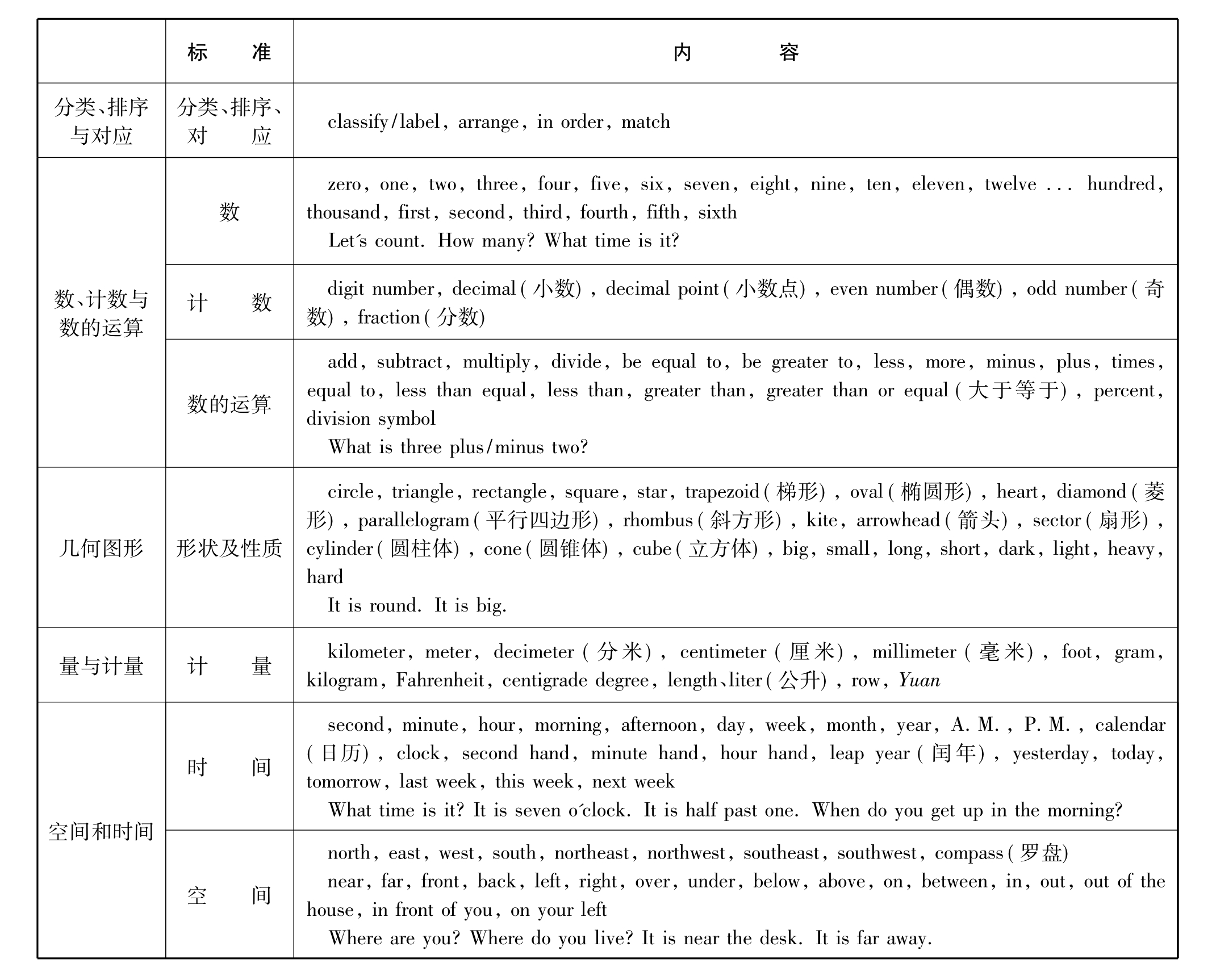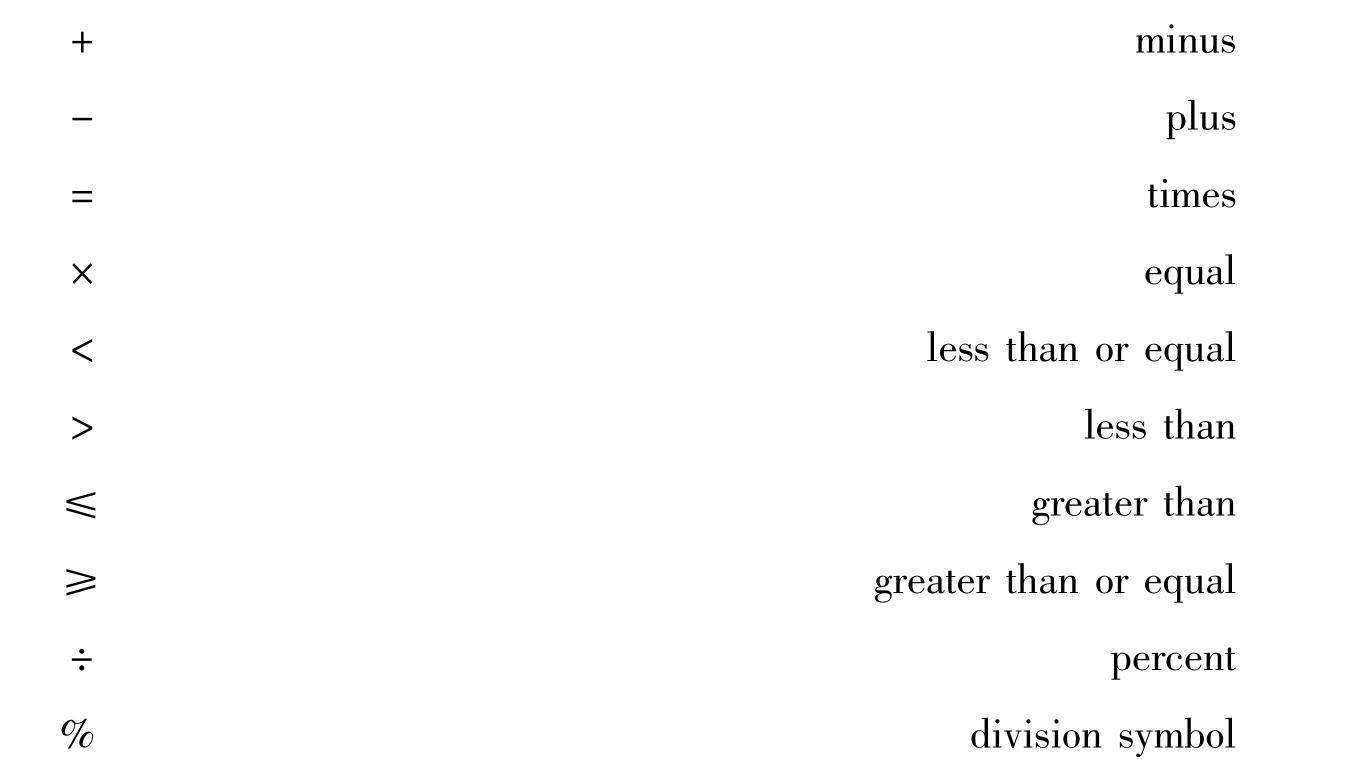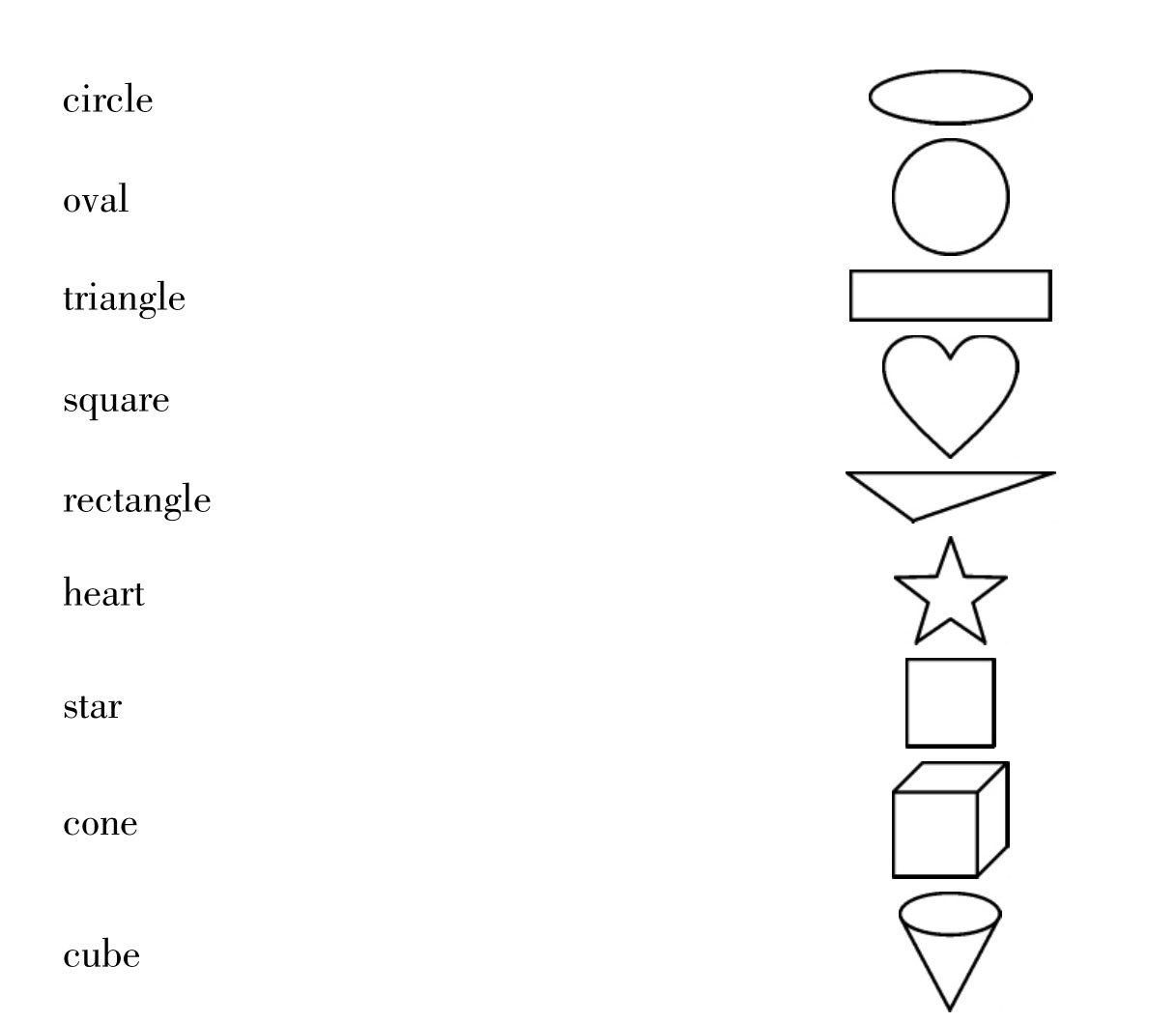一、幼儿数学中的英语渗透
数学学科的双语教学不是把原先的数学教材翻译成英语来教学,而是以学生原有的英语知识为基础,有效地把一定量的英语融合于数学教学之中,使数学学科知识和英语语言合理整合,通过数学学习促进学生一定量的英语语言的积累与获得。在数学双语教学中让学生掌握一些在英语教学中不常接触到的专业词汇,拓展在生活中需要的数学词汇。
(一)幼儿园数学双语知识技能要求的落实
1.抓住基本的数学英语词语,扫除学生的词语障碍,如英语的基数词和序数词的认读、加减乘除算式读法、数学符号“=、>、<”等的读法、简单几何体和平面图形的名称、物体相对空间位置的描述等。同时,注意学生数学的英语听力的提高,培养学生对数字的听力敏感,对度量与方位的快速反应,为学生的数学双语思维奠定坚实基础。
2.在数学双语教学中,要专注基本句型,有效阻止学科语言。数学双语课使用的句型应该尽量是学生学过的,甚至用简单的单词、词组。数学双语课可以使用的句型主要以陈述句为主,如It means ...We can say ...等。要根据学科的要求运用学科语言,尽可能使用简单词句表达数学知识点。
在教学过程中,应该多设置生活情景,让学生能够用所学的英语教学知识来解决实际问题,增加英语学与说、说与用的内容,丰富数学知识习得的体验过程,形成主动用两种语言来解决生活中数学问题的习惯。在双语教学过程中,要提高数学学科语言的复现率,要让学生能够熟练运用新学的学科语言进行听、读。
(二)能基本运用初步的数学英语词汇和句型
数学学科的双语教学不是把原先的数学教材翻译成英语来教学,而是以学生原有的英语知识为基础,有效地把一定量的英语融合于数学教学之中,使数学学科知识和英语语言合理整合,通过数学学习促进学生一定量的英语语言的积累与获得。在数学双语教学中让学生掌握一些在英语教学中不常接触到的专业词汇,拓展在生活中需要的数学词汇。
1.参考词汇

2.参考用语
1)Name some daily objects that match the colors and shapes on the right part.找出你身边具有右图中的颜色和形状的日常物品。
2)Name the color of the following items.请说出下列物品的颜色。
3)What shape is it?它是什么形状的?
4)How many corners/sides does a square/rectangle have?一个正方形/长方形有多少角和边?
5)Can you make a square into two triangle?你能把一个正方形分成两个三角形吗?
6)What differences are there between them?它们之间有什么不一样的吗?
7)Please count these shapes following the demand.请根据要求数出图形的数量。
8)Can you divide five into two and three?你能将5分为2和3吗?
9)Can you find the numbers hiding in the picture?你能找出藏在图画中的数字吗?
10)Please arrange × × in a right order.请按照规律给××排队。
11)Please put the same things together.请把相同的东西放在一起。
12)Please put these things with different colors/sizes/patterns into different ...请按照颜色/大小/图案的不同把这些……放在不同的……里。
13)Can you think of any other way?你还有什么不同的方法?
(三)幼儿园数学双语教学活动例举
案例5 First,Second,Third,Fourth,Fifth 1—5的序数词
苏州市平江区挹秀幼儿园 朱莉娜
Teaching Objectives活动目标
1.熟练掌握5以内的序数,能够从不同方向确定物体在序列中的位置。
2.初步理解first,second,third,fourth,fifth的含义,养成良好的倾听习惯。
3.初步体验师幼互动的快乐。
Preparations活动准备
1.三角形、圆形、正方形、长方形、椭圆形小图形各3张;
2.猫、狗、猴、猪、鸭图片各一张;房子一幢,地上贴有相应的图形标记的火车一列;3.音乐A,B,C。
Procedures活动过程
1.Warming up
Greetings and sing the song Hello.
2.Presentation
T:Look! Here's a tall building.Let's count.How many floors are there in this building?
T&C:One,two,three,four,five.Five.
T:Which is the first floor? Point it out,and paste the number next to it.
(以同法引出second/third/fourth/fifth floor)
T:There're many animals in the building.Who are they?
(教师做动作,让幼儿猜,引出动物pig,duck,monkey,dog,cat。)
T:Who's on the first/second/third/fourth/fifth floor?
3.Activity
T:The animals want to go out.Chug-chug,toot-toot,Chug-chug,toot-toot.Oh,the train is coming.How many carriages are there in the train? Let's count.
T&C:One,two,three,four,five.Five.
T:Which is the first/second/third/fourth/fifth carriage? Point it out.
T:The cat wants to get on the first carriage.Who can help him?
(以同法让pig,duck,monkey,dog上车。动物乘火车,巩固1—5的序数。)
T:Let's get on the train,OK? Our train is leaving.Are you ready?(火车舞)
4.Game
T:We're arriving in the Maths Kingdom.I'll knock at the door.Who's coming?
T:Hi,I'm the king of the Maths Kingdom.Welcome to my kingdom.If you want to get in and play,you must answer the questions,OK? See you later.
T:Take out your shapes and paste them on your forehead.Find the same shapes on the floor.When I say“the first line”,the kids in the first line should jump out,OK?
(站队游戏两次,巩固序数。)
T:Look! Here're three groups of teachers in the red cap.Let's find the teachers,OK?
T:You're good kids.You can go into the kingdom,bye-bye.
T:We're the winners,yeah! Line up.Let's go to the kingdom.Say“bye-bye”to teachers.
案例6 Magic Shapes魔形(中班)
苏州新区实验幼儿园 尚红艳
这个活动是整合了数学、美术方面的内容,小组活动中有三个层次的活动:一是用橡皮筋拉出图形或组合图形;二是按要求找出作业单上各种图形并涂上相应的颜色;三是在图形基础上添画;四是创意拼贴。
Teaching Objectives活动目标
1.熟悉正方形、长方形、圆形、三角形、梯形,了解半圆形、椭圆形,并能用英语描述图形的特征及其变化。
2.能不受图形颜色、摆放形式的影响按照意愿进行拼贴。
3.乐于运用已有的英语经验表达交流,感受拼贴图形的乐趣。
Preparations活动准备
大小不同的正方形、长方形、圆形、三角形、梯形、半圆形、椭圆形若干个;黑色衬板若干;操作纸若干;橡皮筋及衬板若干;三幢不同颜色、形状的房子。
Procedures活动过程
1.机器人拼图,引起幼儿参与活动的兴趣。
T:What shape is it?(出示机器人的身体)I will play a magic.Please close your eyes.(出示完整的机器人拼图)Now,what do you see?
2.通过比较区分正方形、长方形、圆形、三角形、梯形,感知图形的特征。
(1)观察、比较机器人身体的组成部分:What shape is the robot's ...? What color is it? What difference are there between them?(重点比较长方形、梯形)
(2)运用猜谜语的方式比较圆形、正方形。
T:I have four sides and four corners.They are all of equal length.Who am I?(Square)
T:I look like a sun.You can go around me and can not find a corner.Who am I?(Circle)
3.通过观察,比较圆形、半圆、正方形、三角形的变化,重点认识半圆。
(1)观察图形的变化,了解半圆的特点,学习单词semicircle。
T:They are magic shapes.Look! What is in my hand? If I fold the square/circle in half,what will I get? How many rectangles/semicircles will I have?
(2)通过游戏巩固对半圆的认识。
Game:Please find the ...for me.
幼儿根据指令寻找不同颜色、大小的半圆形,并交到教师手上。
(3)通过游戏进一步巩固对各种图形特征的认识。
Finger/Body game:Can you make some shapes with your fingers/body? Look! I can use my fingers to make a square.What shape can you make?运用儿歌对答的形式,请幼儿介绍自己用身体表现的图形:Circle,circle,where are you? Here I am,here I am.I am a circle.
4.迁移经验,了解组合图形的特点。
鼓励幼儿寻找生活中的各种图形:What is it? What does it look like?
通过对三种房子的辨认,了解组合图形在生活中的运用。
T:I will describe the houses.Please guess which house it is.Its roof is a triangle.Its door is a rectangle and its windows are squares and circles.Which house is it?
T:We can use the shapes to make many pictures we like! Do you want to have a try?
5.不受图形颜色、摆放形式的影响尝试将不同图形组成生活中的不同物体。
(1)教师讲解活动要求。
T:We have four games,and you can choose the one you like best.
The first game:You can use ...to make a beautiful picture.
The second one:You can draw the picture following the instructions.
The third one:You can use the different shapes to make a beautiful house.
The last one:You can use the shapes to make your favorite picture.
(2)小组活动,教师指导。
(3)展示作品、讲评。
T:What do you make? Can you introduce it? What shape/color is the ...?
6.结束活动。
T:Your pictures are very beautiful.I like them very much.Now let's go to our classroom.You can introduce them to other children,OK?
案例7 On,In,Under,Behind方位介词
苏州工业园区新馨花园幼儿园 赵 贞
Teaching Objectives活动目标
1.乐于参与活动,体验英语活动的乐趣。
2.熟悉有关方位的介词:on,in,under,behind。
3.复习有关动物的内容。
Preparations活动准备
床,桌子,凳子,房子,箱子,树。
Procedures活动过程
1.Presentation
(1)T:Good morning,everyone.Look.Who is it?
C:A rabbit.
T:I'll tell you today is the rabbit's birthday.(Show the rabbit.)
T:What shall we say to the rabbit?
C:Happy birthday.
T:Louder,please.(Clap your hands.)
(引出兔子今天生日。)
(2)T:Do you know a lot of animals have gone to the rabbit's birthday party? But who are they? Can you guess?
C:Cat/monkey ...
T:So many animals.But(show the action)where are they? Where are they?
T:Let's look for them together,OK?
C:OK.(寻找动物。)
2.At the rabbit's
T:(Knocking at the door)Is there anyone in the box?
T:Yes,I'm in the box.
T:Oh,a cat is in the box.
C:A turtle is in the box ...
T:What about other animals? Let's go on.
T:Is there anyone on the bed?
T:Yes,I'm on the bed.
T:Oh,who is on the bed?
C:...is on the bed.
T:(打呼)Listen.Oh a pig is behind the tree.(Passing by)(A pig is behind the tree.)
T:Oh so many animals are behind the tree.Who wants to get one of them out?
C:...is behind the tree.
C:...is behind the tree.
C:...is behind the tree.
T:Oh so many animals.
T:Cat,monkey,panda,dog,duck ...
T:Where is the ox?
T:I'm here.I'm under the table.
T:Let's ask the ox together.
T:Ox,ox,where are you?
T:I'm under the table.(throwing the ball)
T:There is another animal under the table.Let's ask him.Who is under the table?
T:Loud,please.
C:Who is under the table?
T:...is under the table.
T:Oh all the animals are here.Let's sing the birthday song to the rabbit.OK? But at the same time,let's play a game.You should find a place for yourselves.When we stop singing,you should tell me where you are.OK? Are you ready?
T:...where are you?
C:I am ...
(结合故事,自然感知并熟悉有关方位的介词。)
(四)相关链接
1.国外教案
(1)简单加法
Title—Adding&Counting Butterfly Sums
By—Joanne Capolongo
Primary Subject—Math
Secondary Subjects—Science,Art
Grade Level—K
Materials Needed:One page of four butterflies outlined.
Purpose:The purpose of this activity is to have the children make enough dots on each wing to equal the same sum on each.
Description of Activity:Give each child a page with four butterflies on it.The butterflies should be outlined and show only a blank wing.The child will then put dots on each wing on each butterfly.(Different amount of dots for each butterfly wing.)The wings on each butterfly,combined should all equal ONE sum.(Example:1 + 7 = 8,2 + 6 = 8,3 + 5 = 8,4 + 4 = 8.)Each butterfly should look different.There might be two dots on one wing,and four dots on the other.This would make the sum six.Depending on what sum is to be used,is how many dots should be on each butterfly wing.
(资料来源http://www.lessonplanspage.com)
(2)Shapes
Share print images of animals.Talk about the different colors and shapes of these animals.Tell students that they are going to create pictures of animals with different shapes.They will also draw a picture of the animal's habitat.
Demonstrate using a print image as an example.Talk about different shapes students might see on the animal.What shape are its ears? What shape is its body? Use different size construction-paper shapes to create the animal.Arrange the shapes on the background habitat,being sure to tell students that you will not use glue until it looks the way you want it to.Finally,glue the shapes on the background habitat.Demonstrate using crayons to make additional lines that should appear(such as whiskers)on the animal.
(资料来源http://school.discovery.com)
(3)Learn why numbers are an important part of everyday life
Have students draw a picture showing an example of a time they have used numbers.Give them some examples:standing first or last in line,dividing candy among friends,or having a doctor measure their height.All of these represent important uses of numbers in everyday life.More advanced students could write words or a sentence or two explaining their drawing.
(资料来源http://school.discovery.com)
2.活动参考及资源
(1)math symbol words(数学符号)
Match 10 math symbol words to their pictures.

(2)quadrilateral(四边形)
Match each quadrilateral's picture to its name.

(3)shapes(形状)
Draw lines between the shapes and the words for the shapes.

(资料来源http://www.enchantedlearning.com)
免责声明:以上内容源自网络,版权归原作者所有,如有侵犯您的原创版权请告知,我们将尽快删除相关内容。















